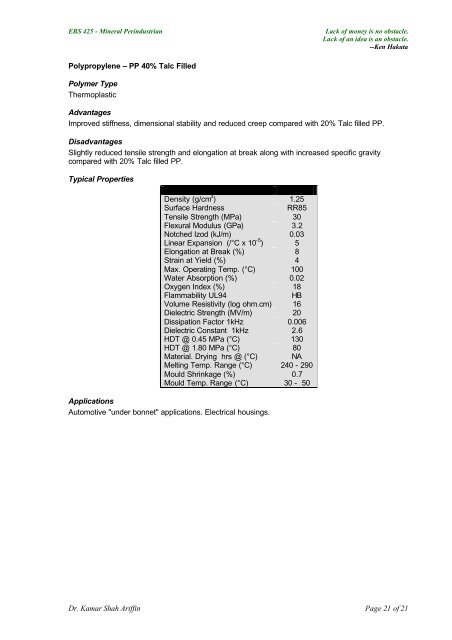Talc and pyrohyllite
Talc and pyrohyllite
Talc and pyrohyllite
Create successful ePaper yourself
Turn your PDF publications into a flip-book with our unique Google optimized e-Paper software.
EBS 425 - Mineral Perindustrian Lack of money is no obstacle.<br />
Lack of an idea is an obstacle.<br />
--Ken Hakuta<br />
Polypropylene – PP 40% <strong>Talc</strong> Filled<br />
Polymer Type<br />
Thermoplastic<br />
Advantages<br />
Improved stiffness, dimensional stability <strong>and</strong> reduced creep compared with 20% <strong>Talc</strong> filled PP.<br />
Disadvantages<br />
Slightly reduced tensile strength <strong>and</strong> elongation at break along with increased specific gravity<br />
compared with 20% <strong>Talc</strong> filled PP.<br />
Typical Properties<br />
Property Value<br />
Density (g/cm 3 ) 1.25<br />
Surface Hardness RR85<br />
Tensile Strength (MPa) 30<br />
Flexural Modulus (GPa) 3.2<br />
Notched Izod (kJ/m) 0.03<br />
Linear Expansion (/°C x 10 -5 ) 5<br />
Elongation at Break (%) 8<br />
Strain at Yield (%) 4<br />
Max. Operating Temp. (°C) 100<br />
Water Absorption (%) 0.02<br />
Oxygen Index (%) 18<br />
Flammability UL94 HB<br />
Volume Resistivity (log ohm.cm) 16<br />
Dielectric Strength (MV/m) 20<br />
Dissipation Factor 1kHz 0.006<br />
Dielectric Constant 1kHz 2.6<br />
HDT @ 0.45 MPa (°C) 130<br />
HDT @ 1.80 MPa (°C) 80<br />
Material. Drying hrs @ (°C) NA<br />
Melting Temp. Range (°C) 240 - 290<br />
Mould Shrinkage (%) 0.7<br />
Mould Temp. Range (°C) 30 - 50<br />
Applications<br />
Automotive "under bonnet" applications. Electrical housings.<br />
Dr. Kamar Shah Ariffin Page 21 of 21


